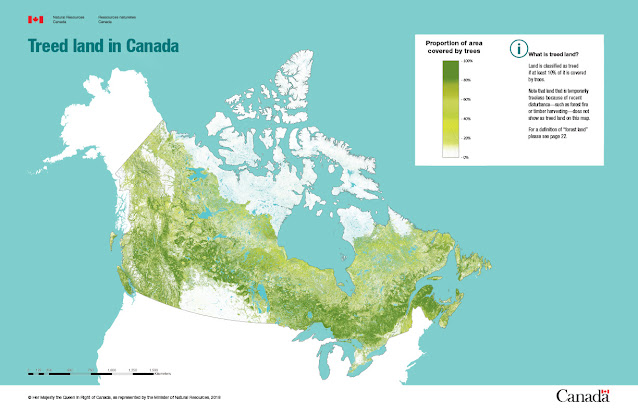To be fair, the Jack pine is not the most impressive species out there. We mix some Jack pine into our species mixes sometimes, but that's more for diversity than because it's a major contributor to carbon capture. We also plant two other types of pine (Norway and Eastern White) in larger quantities. Still, diversity is important. What happens if global warming raises average temperatures by several degrees over the next few decades? This could have a seriously negative effect upon many of the species currently growing in Canada, and we think that Jack pine is the conifer that is least likely to be affected if temperatures do get that high (eastern white pine being the second least vulnerable).
Here's a photo of some Jack pine trees, courtesy of Wikipedia. I'll try to replace this photo with one of my own at some point:
The range of the Jack pine is quite broad. There are a lot of different species of pine trees in the world (about 120, depending on whom you ask). In western Canada, you can find about twenty different pine species, four of which I've planted while working in commercial operations. In eastern Canada, you can find about thirteen species, three of which we plant at Replant.ca Environmental. As far as I'm aware, Jack pine has the largest geographic distribution range within Canada (of the pines). Here's a graphic from Wikipedia to illustrate that:
Despite its broad range and hardiness, the reason that Jack pine is often omitted from "favorite tree" lists is because it doesn't grow as large as some other types (such as Eastern white pine), and the trunk doesn't often grow as straight or majestically. Due to this, many foresters and carpenters don't get as excited by Jack pine as they do by other types of pine, although to be honest, this probably has saved more than a few individual trees from the axe. Under good growing conditions, Jack pine usually only reaches a height of 15-20 meters at maturity (50-65 feet), and the trunk doesn't often exceed a diameter of about 50 centimeters (one and a half feet). As mentioned, the trunks can often be twisted or knotty, so when it is used commercially, it is often more likely to be used for pulpwood than for lumber.
Jack pines can be affected by quite a few diseases. There are weevils and sawflies and budworms that attack the trees. Jack pine can also be affected by a disease called sweet fern blister rust. When this happens, Jack pine is an inadvertent victim. Normally, sweet fern blister rust affects sweet ferns, but the spores can drift onto Jack pine and attack the trees too.
Jack pine is somewhat similar to lodgepole pine, which we plant very frequently on commercial projects all over the west coast. Like lodgepole pine, the cones of Jack pine tend to open during periods of extreme heat (including wildfires). Remember that occasional mild wildfires can be beneficial to the overall forest ecosystem. However, Jack pine don't regrow in densities as thick as lodgepole does after a fire. Also, on a mature tree, the Jack pine cones look quite different because they usually point forward along the branches.
When trying to identify a pine tree, it's always important to see how many needles come in each cluster. Each pine species is quite distinct, usually having either two, three, or five needles per cluster. Jack pine is a two-needle pine.
When I talked about eastern white pine, I mentioned one of Tom Thomson's famous paintings, "Byng Inlet, Georgian Bay." The Jack pine is featured in an even more well-known painting by Tom Thomson, entitled "The Jack Pine." That painting is currently held by the National Galley of Canada. Here's an image of that very recognizable painting, courtesy of the NGC:
Although the Jack pine will probably never feature heavily in our mixes, we have to give it credit for being sturdy and hardy, which is why this species is the most common tree found throughout Canada! I'll leave you with a photo of some of our Jack pine seedlings:
Thanks for reading ...
- Jonathan Clark
www.replant-environmental.ca
Replant.ca Environmental is a Canadian company that plants trees for carbon capture and builds community forests. We also plant trees in national, provincial, and municipal public parks to mitigate damage from wildfires, storms, insects, and forest diseases. We operate thanks to numerous small contributions from the general public, in addition to larger project sponsorships from businesses and corporations around the world. If you'd like to learn how to show your support, visit our donations page. Even if you aren't able to make a contribution, we very much appreciate when people are able to share our posts or our website link on social media, to help spread the word about the work that we're doing!
Teachers are welcome to use content from this post for their classes. If you know a teacher who might like to use this information, please share it with them! The more that people learn about trees, the better our world will be.
To learn more about the various species that we plant, visit the conifers page or the deciduous (hardwoods) page on our website. Thanks so much for your interest!
Incidentally, our organization is often seeking additional land for our carbon capture projects. Please visit this link if you might know of a recently-harvested property that we could rebuild into a permanent legacy forest.















